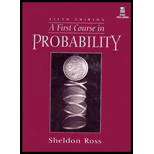Sorry! We don’t have solutions for this edition yet.
Solutions are available for other editions of this book
View 9th Edition solutionsarrow_forwardView 10th Edition solutionsarrow_forwardBook Details
This market leading introduction to probability features exceptionally clear explanations of the mathematics of probability theory and explores its many diverse applications through numerous interesting and motivational examples. The outstanding problem sets are a hallmark feature of this text.
Probability is a difficult topic for many students. It often appears counter-intuitive and confusing. This text presents the material in a way that enhances the student's intuition and understanding by presenting complete, clear explanations. Whereas many books end their discussion of an example after arriving at a result that seems surprising, this book continues on to present an intuitive explanation. Illustrations of this feature include the following examples:
The Birthday Problem (5i in Chapter 2)
The Ace of Spades (5j in Chapter 2)
Surgery? (3d in Chapter3)
The Best Prize (4I in Chapter 7)
Extensive exercise sets with a wide variety and level of problems.
NEW--discussions of important topics including:
The odds-ratio.
Independence is a symmetric relation.
Exchangeable random variables.
NEW--Chapter Exercises are reorganized and expanded to benefit students:
The more mechanical Problems now come before the Theoretical Exercises.
Many new problems (over 150) have been added to the text-many with multiple parts.
NEW--Self-Test Problems and Exercises now conclude the Chapter Exercises
Complete, worked-out solutions to these new problems appear in Appendix B.
NEW--Many new and updated examples including:
The two girls problem (3j in Chapter 3).
An analysis of the quicksort algorithm (2o in Chapter 7) and (5b, 5d and 5e in Chapter 2), (3c and 7e in Chapter 6), and (6k and 6m in Chapter7).
NEW--Probability Models Disk. Each copy of the book includes a PC Diskette that contains six probability models that are referenced in the text and allow students to quickly and easily perform calculations and simulations.
Three derive probabilities for, respectively, binomial, Poisson, and normal random variables.
Another illustrates the Central Limit Theorem.
Two illustrate the strong law of large numbers.
More Editions of This Book
Corresponding editions of this textbook are also available below:
